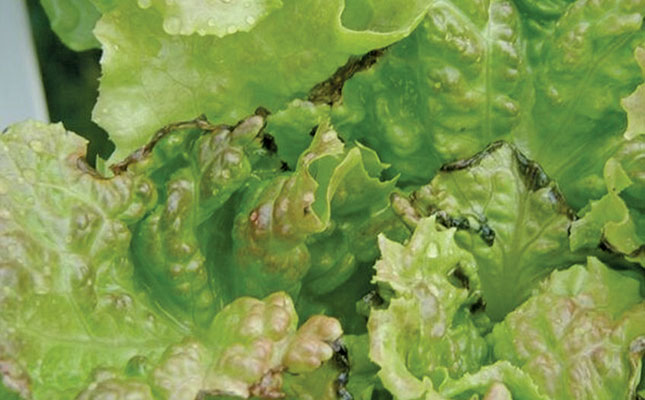
Photo: Lindi Botha
Calcium has not been labelled the problematic nutrient without good reason. Managing calcium absorption in crops requires an intricate balance between applying enough of this and other elements to ensure that a healthy crop is produced.
According to Lindi Grobler, the owner of Agri-Alchemi, few tunnel farmers have not, at one point or another, seen a calcium deficiency in their crops, or experienced a problem with the uptake of calcium.
“Unfortunately, much of the advice given involves simply adding more calcium, which seldom solves the problem. The answer, rather, lies in understanding why calcium uptake is so problematic and then finding the right solution for your crop.”
She notes that solving calcium deficiency does not involve a quick fix; it is a long journey to rectify imbalances.
Identifying the problem
Grobler explains that when a plant is stressed, it absorbs little or no calcium. The first step, therefore, is to ensure that the plant is in an optimal environment.
“When a plant experiences stress, the first element that becomes problematic is calcium. This, in turn, causes a number of problems with growth.”
specific deficiency symptoms are crop-dependent, calcium deficiencies are usually more pronounced in young plant tissue due to little or no translocation of calcium into the phloem of the plant.
“When trying to identify a calcium deficiency in your crop, pay attention to the roots and fruit, as they are more susceptible. Membrane structure disintegration will be more visible. This includes tip burn or curly leaves on lettuce; young tissue scarring or disintegration on young fruit tissue (such as blossom-end rot); root tip dieback; and leaf deformation and twisting.”
Farmers should be careful not to confuse sunburn with calcium deficiency, Grobler cautions.
“In many instances when you see blotches on the fruit, it can be sunburn. Blotches as a result of a lack of calcium are always on the underside of the fruit.”
Brix level in the plant is a good indicator of the calcium level.
“A high Brix means that there’s sufficient calcium in the plant and all the other quality-connected elements such as potassium and magnesium are in balance. A low Brix level is therefore a good indicator of a calcium problem on its own, or that the other elements, specifically potassium, are not in balance.”
Calcium uptake troubleshooting
Many factors play a role in correcting calcium deficiency:
*A distracted nutrient
Maintaining the correct levels of calcium is challenging, as calcium does not always respond when the plant tries to absorb it (hence it being referred to as a ‘distracted’ or passive nutrient).
This means that it is not distributed and put to work in the plant like other nutrients. “The xylem continuously moves up in the plant, transporting nutrients that include calcium,” explains Grobler.
“But calcium tends to get waylaid on its way up, getting stuck in the cell walls of the plant, where it’s not really needed. One needs to get the calcium to the entire plant (the plant itself cannot do it) and that’s not easy.
“Calcium is also protected by other elements, particularly potassium and nitrate nitrogen, so it’s important to get the right balance of nutrients in your fertiliser programme.”
*Lack of transpiration
Simply adding more calcium to a calcium-deficient plant does not solve the problem, says Grobler. Uptake is dependent on the movement of calcium in the xylem.
“Upward movement can only take place efficiently when the plant is transpiring actively. Therefore the transport of calcium within the plant is a direct function of transpiration.
“The moment that transpiration is slowed or halted, calcium uptake and transport are limited, slowed or halted completely.
“Environmental conditions dictate transpiration in a plant, so adding more calcium will not mean more calcium is absorbed; transpiration is the key, not the amount of calcium applied.
“In greenhouse production, temperatures should therefore be kept more constant, as in a controlled and cooler environment the plant tends to absorb calcium from the roots. Ambient temperatures need to be lowered through any means if needed.”
*Low uptake
Grobler notes that even if abundant quantities of calcium are present in the soil, only a low concentration is available for absorption.
“This is due to the lyotropic series, where any clay soil particles will adsorb calcium in preference to magnesium, potassium and sodium.
“Thus, if a high concentration of calcium is supplied through nutrition and the soil balance is not ideal, the soil will adsorb* the calcium, which then makes the calcium unavailable to the plant.
The soil thus prefers calcium and can take applied calcium away from the plant through adsorption. Once adsorbed, it is picked up in an ammonium acetate soil analysis, but it’s not available to the plant. So calcium may be abundant in the soil, but little may be available for uptake.
“Nutrient balance in a fertigation programme is of great importance, with soil amelioration to ensure that the exchange complex of the soil is in balance. This will allow for calcium supplied through a fertigation or fertilisation programme to be available for the plant to use,” Grobler explains.
*Vacuole calcium deposited as insoluble forms
When transpiration is active, the plant binds the calcium onto cell walls to form pectate and polysaccharides, which makes it unavailable for further transport through the plant.
“When it does get into the vacuole through transportation in the xylem, it cannot get to the flower as it is ‘used’ up by the rest of the plant before reaching the flower,” Grobler explains.
A controversial solution may be night-time foliar feeding, as calcium uptake is increased in the late afternoon to early evening. However, Grobler cautions that foliar feeds must be managed meticulously to prevent the problem from escalating due to the wet soil and leaf area, which can increase the prevalence of mildew.
“Foliar feeds work, but can never be the main source of calcium to the plant. You’re limited in the concentration increase you can affect through foliar feeding.”
She says the quality of product is important as some are absorbed into the plant more readily than others.
*Nutrient interaction and antagonism
A lack of calcium could be due to nutrient interaction and antagonism. This is when there is decreased availability of a nutrient to a plant due to the action of other nutrients.
It is in contrast to synergism, where there is an increased availability of a nutrient to a plant due to the increase in the level of another nutrient.
Potassium is antagonistic towards calcium, so if there is too much potassium in the solution, the calcium uptake will be negatively affected. High nitrate nitrogen can also limit the uptake of calcium, so changing a fertigation compound away from a nitrogen-based calcium product will be beneficial.
“There’s no silver bullet in fixing calcium problems, so farmers require programmes that have been specifically designed for their crop, variety and growing practices to ensure the right balance. A specially designed programme might not solve all of your problems, but will go a long way to improve your crop,” Grobler says.
Email Lindi Grobler at [email protected].











